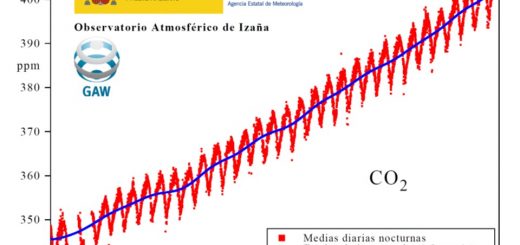Ozone and UV Program
Objectives
The three main objectives of the Ozone & UV Program are:
-
Ozone and UV radiation monitoring with the highest precision and long term stability available with the current technology and scientific knowledge.
-
Research the evolution of ozone and UV in the subtropical region.
-
Investigate instrumental and methodological techniques improvement for measuring ozone.
Network for the Detection of Atmospheric Composition Change (NDACC) program. A long-term total ozone series is shown in the following figure:

A part of the NDACC program, the main activity concerning total ozone is the maintenance of the Regional Brewer Calibration Center for Europe (RBCC-E).
The Regional Brewer Calibration Center- Europe (RBCC-E)
Calibrations of Brewer spectrophotometers for total ozone observations can be performed either by intercomparison against a reference instrument (the most frequent method) or by absolute calibration using Langley method (feasible only at specific high mountain sites with pristine skies). At present, there are about 50 brewer spectroradiometers in Europe; most of them are calibrated individually on a rather low level of coordination. Although the IZO triad is regularly calibrated by the Langley method, this absolute calibration is not used for definition of a new calibration scale. The World triad reference, maintained by the Meteorological Service of Canada (MSC), is respected as the official reference of the GAW Brewer international scale. The RBBC-E instruments have the purpose to spread the above mentioned reference to Brewers operating in Europe and recently in Northern Africa. The IZO and MSC triads are linked by the Canadian travelling reference Brewer 017, which is brought to RBCC-E on a yearly basis. The establishment of an IZO triad allows the implementation of a self -sufficient European Brewer calibration system that respects the world scale but works as an independent GAW infrastructure.
Important objectives such as validation of satellite instruments operating under European space missions are possible after a reliable calibration system such as the RBCC-E. The function of RBCC-E also allows development and testing of new measurement techniques for the ground Brewer network like zenith, UV or aerosol optical depth measurements.
The most remarkable projects of the RBCC-E are the following:
- RBCC-E Calibrations: Selected Brewers from Europe and North-Africa will be operated in parallel to the European reference instruments (triad and/or traveling reference). Campaigns are planned in Spain, Switzerland and Northern Africa.
- Langley Calibrations: The European standard Dobson will be operated at Izana together the European double Brewer reference triad. The performance and calibration of the Dobson will be evaluated and assessed.
- Nordic Calibrations: The Brewer from the Finnish Meteorological Institute (FMI), operational since 1988, will be operated for 4-6 weeks in parallel to the European double Brewer reference triad at Izana (during the Northern Polar Winter). The premise is to perform an absolute calibration of the Finnish Brewer and transfer this information to other Nordic instruments.
2. AECI-WMO GAW-Sahara Project: The International Agency for Cooperation to the Development of Spain, through GAW-WMO, has financed a double Brewer to be installed in the Global GAW Tamanrasset station (Algeria) in early 2010. In 2009 the RBCC-E will provide training to the Tamanrasset staff, and calibration services to the double Brewer. The final installation of the Brewer will be also performed by the RBCC-E. The Tamanrasset station operates on a long term basis a Dobson spectrophotometer. So, Tamanrasset will become one of the few places in the world for studying Brewer-Dobson differences (highly recommended by the SAG-Ozone) and a unique site for satellite validation over a desert environment.
Other past RBCC-E missions have been the following:
– Participation of the RBCC-E traveling reference Brewer in the two SAUNA campaigns (March and April 2006 and 2007, respectively) financed by NASA.
– Brewer team training, repairing, calibration and installation of the Brewer#155 at the Artigas Antarctic Base (Antarctic Institute from Uruguay).
– Brewer team training, repairing and calibration (2005 and 2007) of the double Brewer#165 and single Brewe #051 located at Casablanca (Direction de la Météorologie Nationale; Morocco).
Detailed and up-to-date information about the RBCC-E calibration campaigns can be found on RBCC-E web site.
Ozone vertical profiles Program
-
Sensor: ECC-A6
-
Radiosonde: RS-92
-
Interface: RSA 11
-
Balloon: TOTEX TA 1200
-
Receiver: Digicora Marwin MW-11
-
Wind system: GPS
-
Data acquisition system: Väisäla Met graph with NASACONV.
This program is part of the NDACC network. The NDACC quality control and quality assurance requirements are met at Tenerife ozonesonde station. Data is routinely archived into the NDACC and NILU databases. Tenerife station has participated in annual THESEO campaigns and in field experiments carried out in the framework of different EC projects (BOA, CRISTA and REVUE).
Ozone sounding, Santa Cruz de Tenerife
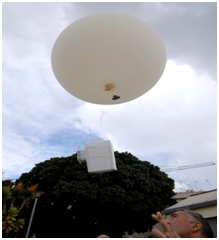
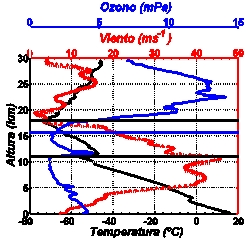
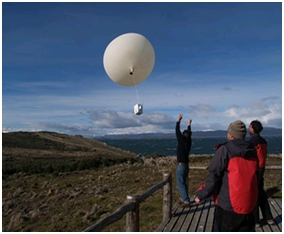
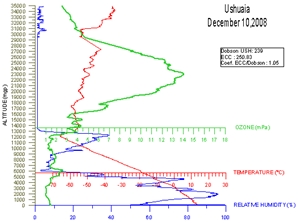
Ultraviolet Radiation
Spectral UV radiation is routinely measured by the Brewer spectrophotometer. UV scans within 290-325 nm range (1991-1998) and 290-365 nm range (1998-now) are taken every half an hour. Due the short wavelength range of the Brewer, the UV radiation is also measured since 1999 with a Bentham DM 150 spectrometer (250-600 nm). The Bentham spectrometer is updated now to meet NDACC requirements and is the main instrument to monitor spectral UV radiation. Recently, a UV-VIS CCD spectrometer has been set up at IZO for measuring global and direct spectral radiation at the 300-900 nm range.
A new web-based database has been designed to manage all the information from the NILU Antarctic Network. This new tool allows the user to see measurements taken by the NILU-UV radiometers in an organized manner, to process calibrations automatically, and to obtain in real time the total ozone content and the UV radiation following the Quality Control application. This system allows us to monitor the evolution of the ozone layer and UV radiation in the Antarctic region, which is of particular interest during the period of formation of the Polar Vortex.
Infrastructures
The infrastructures for the ozone and UV program consists basically on the terrace of the observation tower at Izana Observatory (IZO), the terrace of the Observatory at Santa Cruz (SCO), and the laboratory and ozonesonde launching platform at the Meteorological Center of Santa Cruz de Tenerife. This facility will be moved to the Botanic garden in Puerto de la Cruz (northern part of the Tenerife Island) within 2009.
Instrumentation
|
Brewer Spectroradiometers: Spectroradiometer: Double monochromator 290-365 nm range, focal 160 mm, FHWM=0.6 nm. |
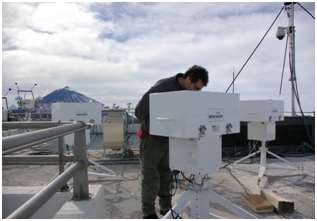 |
|
Bentham Spectroradiometer Bentham DM 150 Double Spectroradiometer:
|
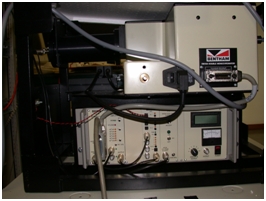 |
|
NILU-UV MULTICHANNEL RADIOMETER
|
 |
|
CCD- Spectrometer Global and Direct input optics |
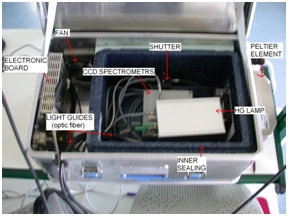 |
Projects
- Budget of Ozone over the North Atlantic (BOA) (Environmental Program EV5V-CT93-0315).
- Investigation of the Oxidizing Capacity of the Atmosphere by Measurement of All Relevant Parameters Over Areas of Different Meteorological Conditions and Different Pollutional Impact (Environmental Program EV5V-CT-93-0321).
- Stratospheric Climatology Using Ultraviolet-Visible Spectroscopy (SCUVS); 1994-1996.
- Reconstruction of Vertical Ozone Distribution from Umkehr Estimates (REVUE), (Environmental Program ENV4-CT95-0161).
- Scientific UV DAta Management; EU (Environmental Program ENV4-CT95-0177).
- Standardization of Ultraviolet Spectroradiometry in Preparation of an European Network; EU (Environmental Program, ENV4-CT95-0056).
- TRansport of Chemical species Across the Subtropical tropopause (TRACAS), (Environmental Program ENV4-CT97-0546).
- Small Scale Structure Early Warning and Monitoring in Atmospheric Ozone and Related Exposure to UV-B Radiation (STREAMER), (Environmental Program ENV4-CT98-0756).
- SCOUT- O3 (Stratosphere – Climate Links With Emphasis On The UTLS)
- Medida y Modelización de la Distribución Espacio-Temporal de la Irradiancia Solar Ultravioleta en España. Programa Nacional del Clima CLI97-0345-05.
- Red Antártica para la vigilancia y Caracterización de la Radiación UltraVioleta (RACRUV). Programa Nacional de Investigación Antártica ANT98-0179.
- Control de Calidad de la Red Antártica para la vigilancia y Caracterización de la Radiación UltraVioleta (CRACRUV). Programa Nacional de Investigación Antártica REN2000-0245-C02-02.
- Determinación y predicción de la radiación ultravioleta solar en España: influencia de la columna de ozono, partículas aerosoles y nubosidad. Programa Nacional del Clima REN2000-0903-C08-02 CLI.
- Determinación y predicción de la radiación ultravioleta solar en España: Influencia de la columna de ozono, partículas aerosoles y nubosidad (DEPRUVISE) (CLI2000-0903-C08) (2001-2004).
- ROBOT (Red de Observación Brewer para la Medida Automática de Espesor Óptico de Aerosoles); Plan Nacional I+D (CGL2004-05984-C07-06).
- MANA (Red Antártica para la medida de Aerosoles); Plan Nacional I+D (CGL2004-05419-C02-02/ANT)
- TROMPETA (“TROpical Monitoring Phase in the Atmosphere”); Plan Nacional I+D (CGL2004-03669/CLI)
- UVEMA (2005- 2009): Effects of UV radiation and other environmental parameters on materials
- SAUNA; Intensive campaigns in Södankyla in Marc-April 2006 and 2007, financed by NASA
- EU Action COST 723 (“The Role of the Upper Troposphere and Lower Stratosphere in Global Change”; www.cost723.org/) thro
- EU Action “Long term changes and climatology of UV radiation over Europe”
International intercomparison campaigns (since 2005)
- An intercomparison campaign of seven UV spectroradiometers of different types took place at Izaña Observatory in June 2005. The campaign was focused primarily on spectral measurements of direct solar irradiance. Among the objectives was to improve the quality of direct solar irradiance spectral measurements, through instrumental modifications and standardization of calibration techniques, as well as to assess the significance of the differences in the field of view of the spectroradiometers with respect to aerosols and to solar zenith angle.
- In September 2005 and September 2007 were held the first and the second, respectively, Brewer intercomparison campaigns at El Arenosillo station (INTA). The scientific coordination and organization corresponded to the GAW Regional Brewer Calibration Center for Europe (RBCC-E). During the second Brewer intercomparison in 2007 a Dobson intercomparison campaign was organized by the Regional Dobson Calibration Centre-Europe (WMO-RDCC-RA-VI) Meteorological Observatory Hohenpeissenberg (Germany). During the first days both calibration campaigns performed in parallel, while the last days were used for a Dobson/Brewer comparison. In the two Brewer intercomparisons two Brewers from Morocco were fitted and calibrated.
- The third RBCC-E intercomparison was held at the Arosa Observatory (MeteoSwiss).
- The RBCC-E has hosted the first intercomparisons of the World and European Brewer and Dobson reference instruments at Izaña on September 7-27, 2008.
Staff
Coordinator: Alberto Redondas
RBCC-E: Juanjo Rodríguez (AEMET – graduate student)
NILU Antarctic network: Fernando Almansa (AEMET- graduate student)
Ozonesonde program: Sergio Afonso (AEMET)
Laboratory: Carmen Guirado (UVA-AEMET PhD contract)
Modeling:
UVI Forecasting: Virgilio Carreño (AEMET)
QA/QC: Rosa García (UVA-AEMET PhD contract)
Publications
Schneider, M., A. Redondas, F. Hase, C. Guirado, T. Blumenstock, and E. Cuevas, “Comparison of ground-based Brewer and FTIR total column O3 monitoring techniques”, Atmospheric Chemistry & Physics, Vol. 8, Sep. 2008.
Schneider, M., F. Hase, T. Blumenstock, A. Redondas, and E. Cuevas, “Quality assessment of O3 profiles measured by a state-of-the-art ground-based FTIR observing system,” Atmospheric Chemistry & Physics, vol. 8, Sep. 2008.
Fioletov, V.E., G. Labow, R. Evans, E.W. Hare, U. Köhler, C.T. McElroy, K. Miyagawa, A. Redondas, V. Savastiouk, A.M. Shalamyansky, J. Staehelin, K. Vanicek, and M. Weber, “Performance of the ground-based total ozone network assessed using satellite data,” Journal of Geophysical Research (Atmospheres), vol. 113, Jul. 2008.
Redondas, A., C. Torres, O. Meinander, K. Lakkala, R. García, E. Cuevas, H. Ochoa, G. Deferrari, and S. Díaz, “Antarctic network of lamp-calibrated multichannel radiometers for continuous ozone and uv radiation data,” Atmospheric Chemistry & Physics Discussions, vol. 8, Feb. 2008.
Schoeberl, M.R., J.R. Ziemke, B. Bojkov, N. Livesey, B. Duncan, S. Strahan, L. Froidevaux, S. Kulawik, P.K. Bhartia, S. Chandra, P.F. Levelt, J.C. Witte, A.M. Thompson, E. Cuevas, A. Redondas, D.W. Tarasick, J. Davies, G. Bödeker, G. Hansen, B.J. Johnson, S.J. Oltmans, H. Vömel, M. Allaart, H. Kelder, M. Newchurch, S. Godin-Beekmann, G. Ancellet, H. Claude, S.B. Andersen, E. Kyrö, M. Parrondos, M. Yela, G. Zablocki, D. Moore, H. Dier, P. von der Gathen, P. Viatte, R. Stubi, B. Calpini, P. Skrivankova, V. Dorokhov, H. De Backer, F.J. Schmidlin, G. Coetzee, M. Fujiwara, V. Thouret, F. Posny, G. Morris, J. Merrill, C.P. Leong, G. Koenig-Langlo, and E. Joseph, “A trajectory-based estimate of the tropospheric ozone column using the residual method,” Journal of Geophysical Research (Atmospheres), vol. 112, Dec. 2007.
Oltmans, S., A. Lefohn, I. Galbally, E. Scheel, G. Bödeker, E. Brunke, H. Claude, D. Tarasick, P. Simmonds, K. Anlauf, F. Schmidlin, K. Akagi, and A. Redondas, “Long-term Changes in Tropospheric Ozone,” AGU Spring Meeting Abstracts, vol. 41, May. 2006.
Lakkala, K., A. Redondas, O. Meinander, C. Torres, T. Koskela, E. Cuevas, P. Taalas, A. Dahlback, G. Deferrari, K. Edvardsen, and H. Ochoa, “Quality assurance of the solar UV network in the Antarctic,” Journal of Geophysical Research (Atmospheres), vol. 110, Ago. 2005.
Schneider, M., T. Blumenstock, F. Hase, M. Höpfner, E. Cuevas, A. Redondas, and J.M. Sancho, “Ozone profiles and total column amounts derived at Izana, Tenerife Island, from FTIR solar absorption spectra, and its validation by an intercomparison to ECC-sonde and Brewer spectrometer measurements,” Journal of Quantitative Spectroscopy and Radiative Transfer, vol. 91, Mar. 2005.
Martínez-Lozano, J.A., M.J. Marín, F. Tena, M.P. Utrillas, L. Sánchez-Muniosguren, C. González-Frías, E. Cuevas, A. Redondas, J. Lorente, X. Cabo, V. Cachorro, R. Vergaz, A. Frutos, J.P. Díaz, F.J. Expósito, B. Morena, and J.M. Vilaplana, “UV Index Experimental Values During the Years 2000 and 2001 from the Spanish Broadband UV-B Radiometric Network” Photochemistry and Photobiology, vol. 76, 2002.
Cuevas, E., M. Gil, J. Rodríguez, M. Navarro, and P. Hoinka, Sea-land total ozone differences from TOMS: The GHOST effect, J. Geophys. Res., Vol. 106, D21, p.p. 27745-27755, 2001.
de Backer, H., P. Koepke, A. Bais, X. de Cabo, T. Frei, D. Gillotay, C. Haite, A. Heikkil, A. Kazantzidis, T. Koskela, E. Kyrö, B. Lapeta, J. Lorente, K. Masson, B. Mayer, H. Plets, A. Redondas, A. Renaud, G. Schauberger, A. Schmalwiesser, H. Schwander, and K. Vanicek, “Comparison of measured and modelled uv indices for the assessment of health risks,” Meteorological Applications, vol. 8, Sep. 2001.
Bais, A.F., B.G. Gardiner, H. Slaper, M. Blumthaler, G. Bernhard, R. McKenzie, A.R. Webb, G. Seckmeyer, B. Kjeldstad, T. Koskela, P.J. Kirsch, J. Gröbner, J.B. Kerr, S. Kazadzis, K. Leszcznski, D. Wardle, W. Josefsson, C. Brogniez, D. Gillotay, H. Reinen, P. Weihs, T. Svenoe, P. Eriksen, F. Kuik, and A. Redondas, “SUSPEN intercomparison of ultraviolet spectroradiometers,” Journal of Geophysical Research, vol. 106, Jun. 2001.
Gröbner, J., R. Vergaz, V.E. Cachorro, D.V. Henriques, K. Lamb, A. Redondas, J.M. Vilaplana, and D. Rembges, “Intercomparison of aerosol optical depth measurements in the UVB using Brewer spectrophotometers and a Li-Cor spectrophotometer,” Geophysical Research Letters, vol. 28, May. 2001
Schulz, A., Rex, M., Harris, N. R. P., Braathen, G. O., Reimer, E., Alfier, R., Kilbane-Dawe, I., Eckermann, S., Allaart, M., Alpers, M., Bojkov, B., Cisneros, J., Claude, H., Cuevas, E., Davies, J., De Backer, H., Dier, H., Dorokhov, V., Fast, H., Godin, S., Johnson, B., Kois, B., Kondo, Y., Kosmidis, E., Kyrö, E., Litynska, Z., Mikkelsen, I. S., Molyneux, M. J., Murphy, G., Nagai, T., Nakane, H., O’Connor, F., Parrondo, C., Schmidlin, F. J., Skrivankova, P., Varotsos, C., Vialle, C., Viatte, P., Yushkov, V., Zerefos, C., von der Gathen, P., Arctic ozone loss in threshold conditions: Match observations in 1997/1998 and 1998/1999, J. Geophys. Res., 106, D7, 7495-7503, 2001.
Díaz, J.P., F.J. Expósito, C.J. Torres, V. Carreño, and A. Redondas, “Simulation of mineral dust effects on UV radiation levels,” Journal of Geophysical Research, vol. 105, 2000.
Armerding, W., F.J. Comes, H.J. Crawack, O. Forberich, G. Gold, C. Ruger, M. Spickermann, J. Walter, E. Cuevas, A. Redondas, R. Schmitt, and P. Matuska, “Testing the daytime oxidizing capacity of the troposphere: 1994 OH field campaign at the Izaña observatory, Tenerife,” Journal of Geophysical Research, vol. 102, May. 1997.

